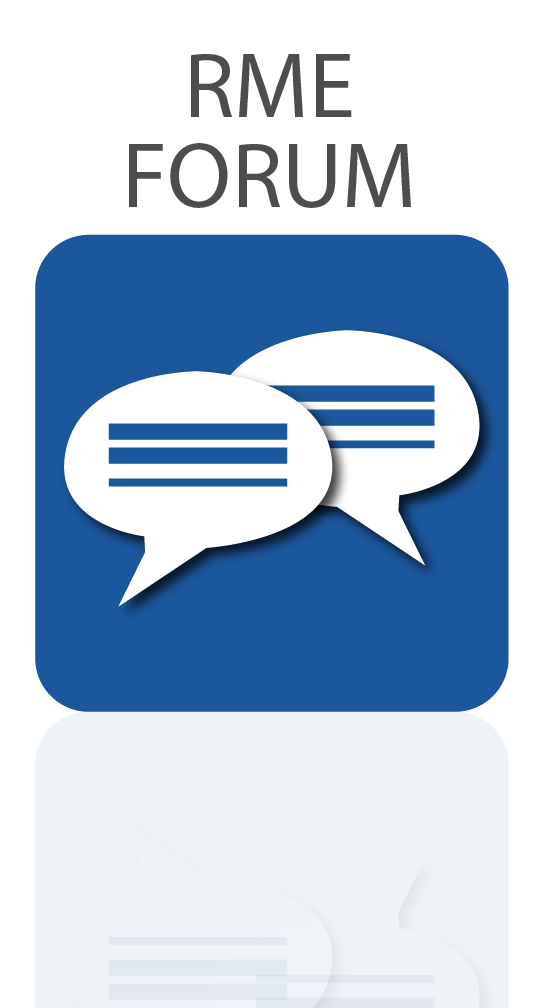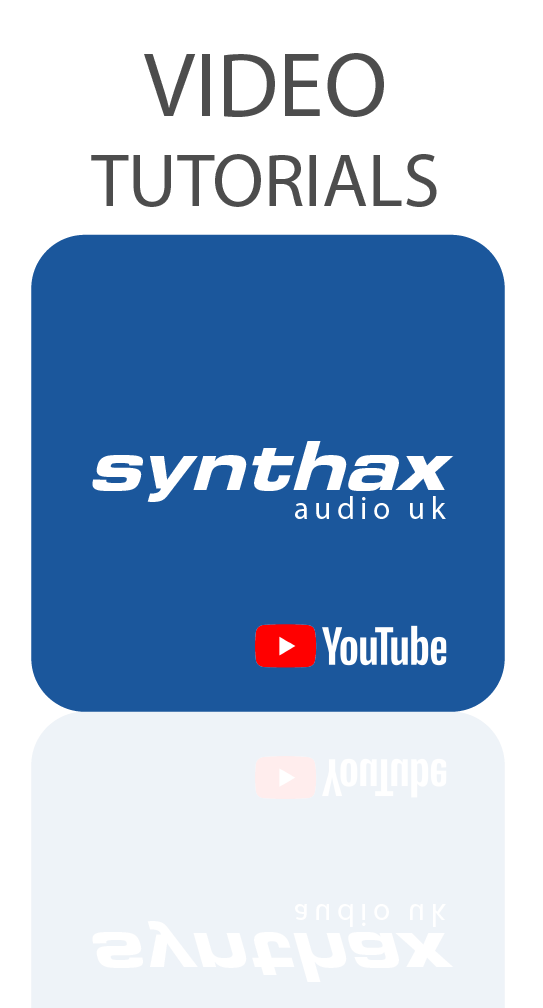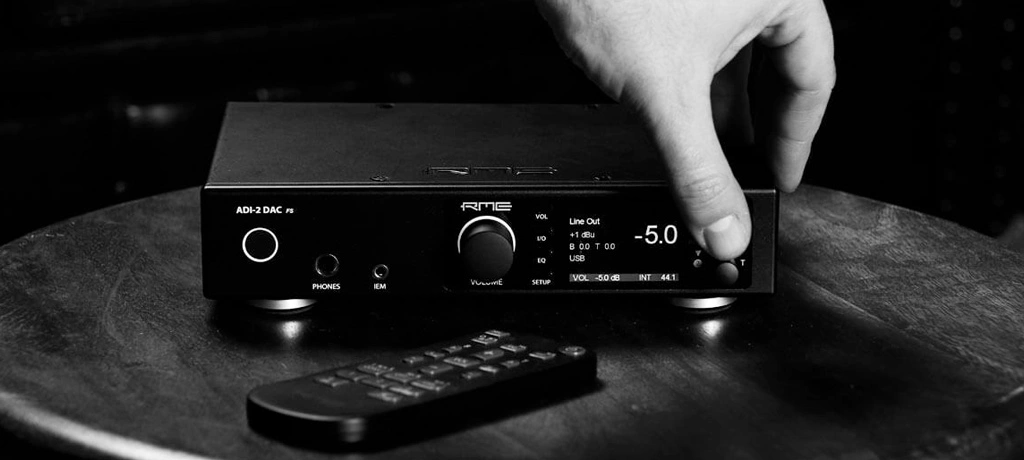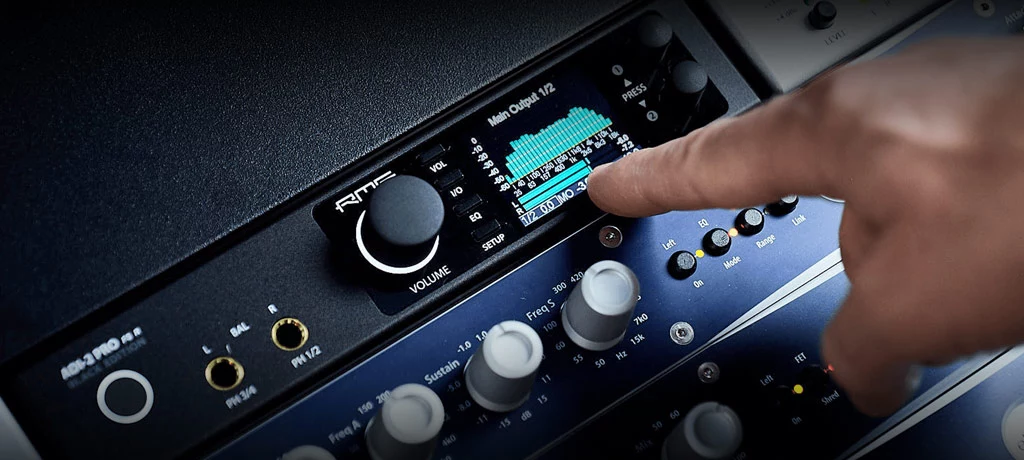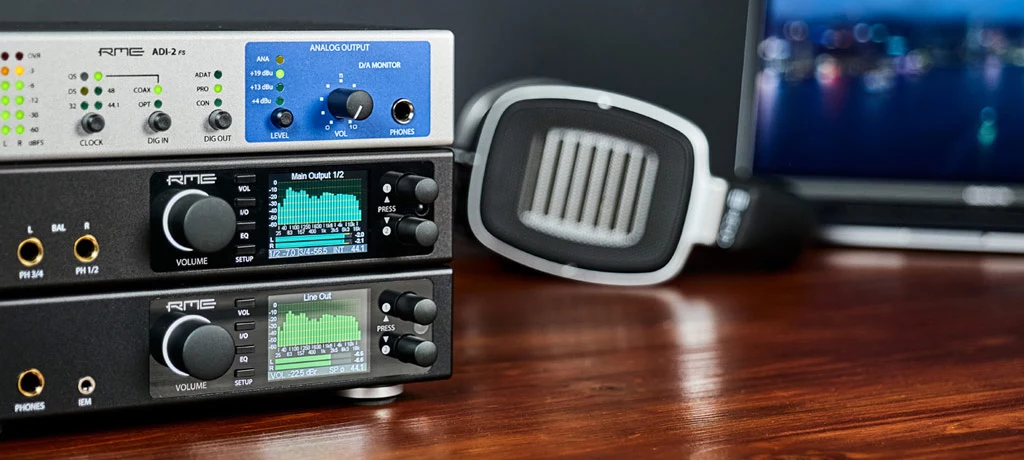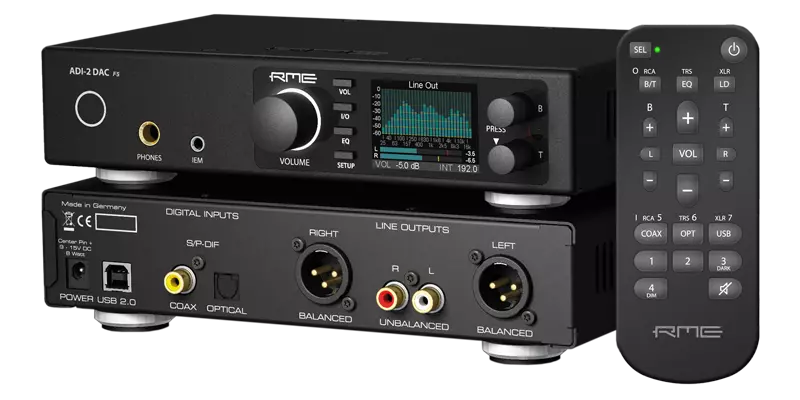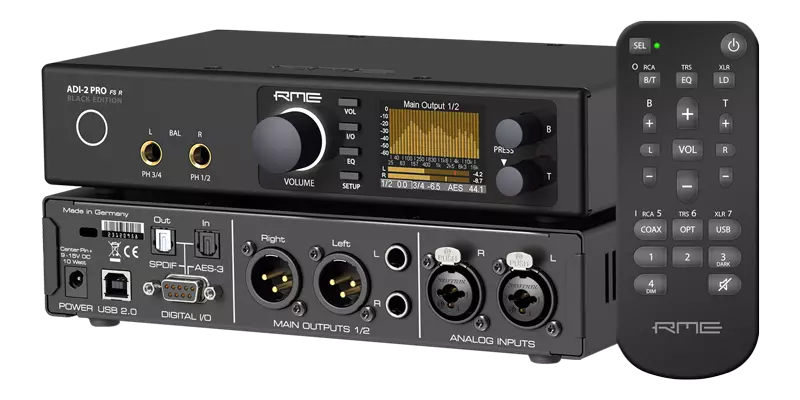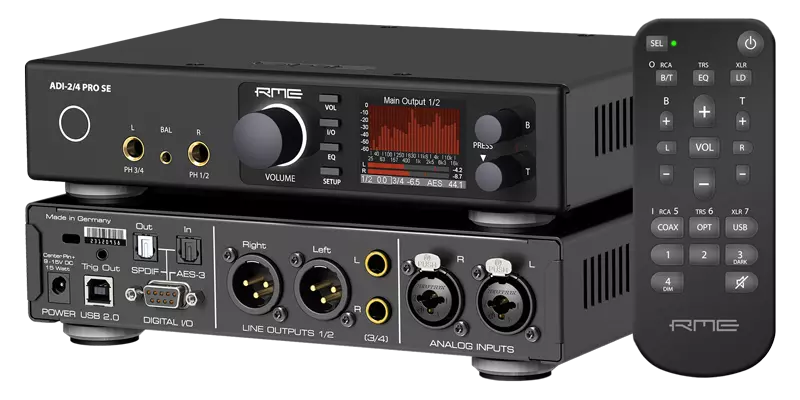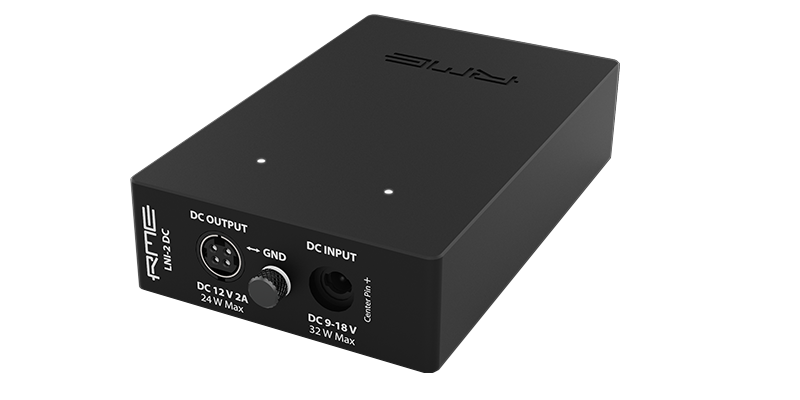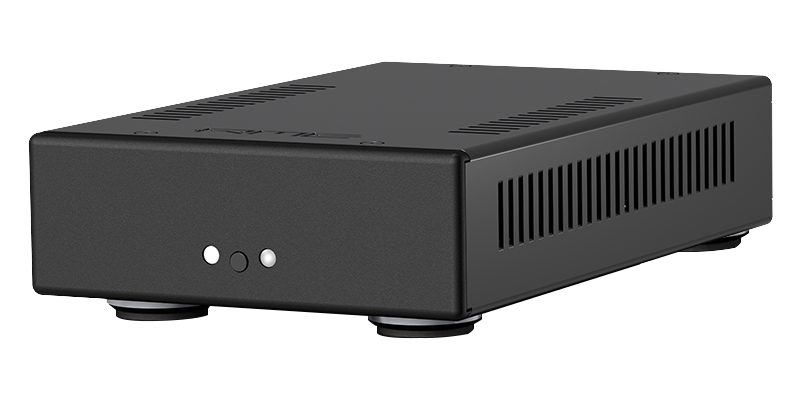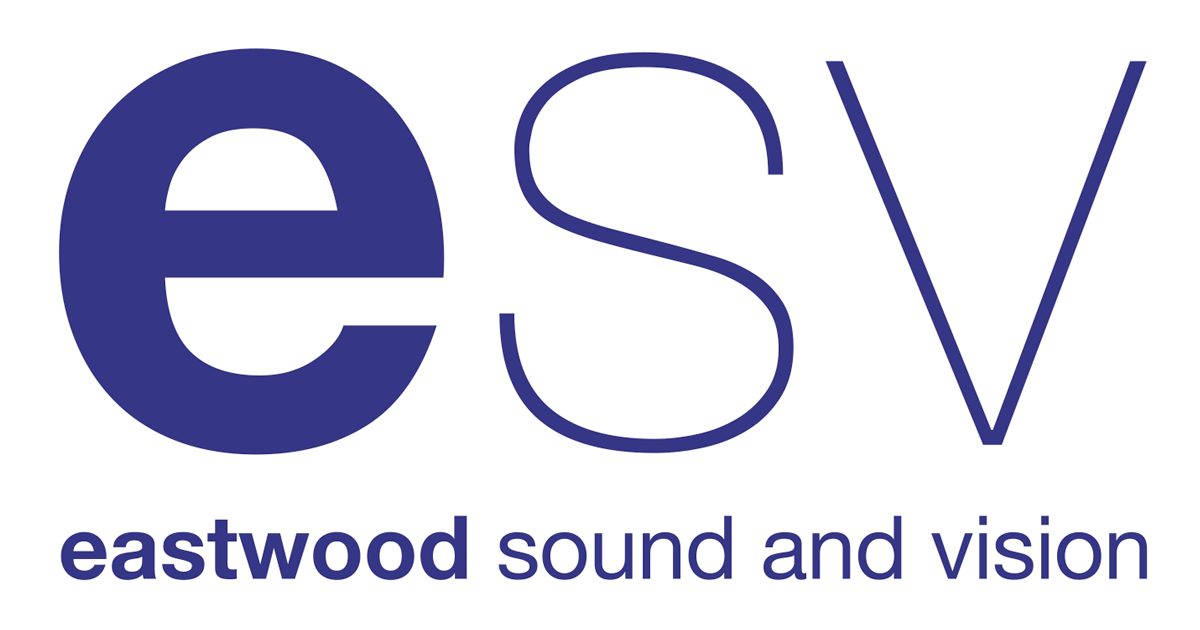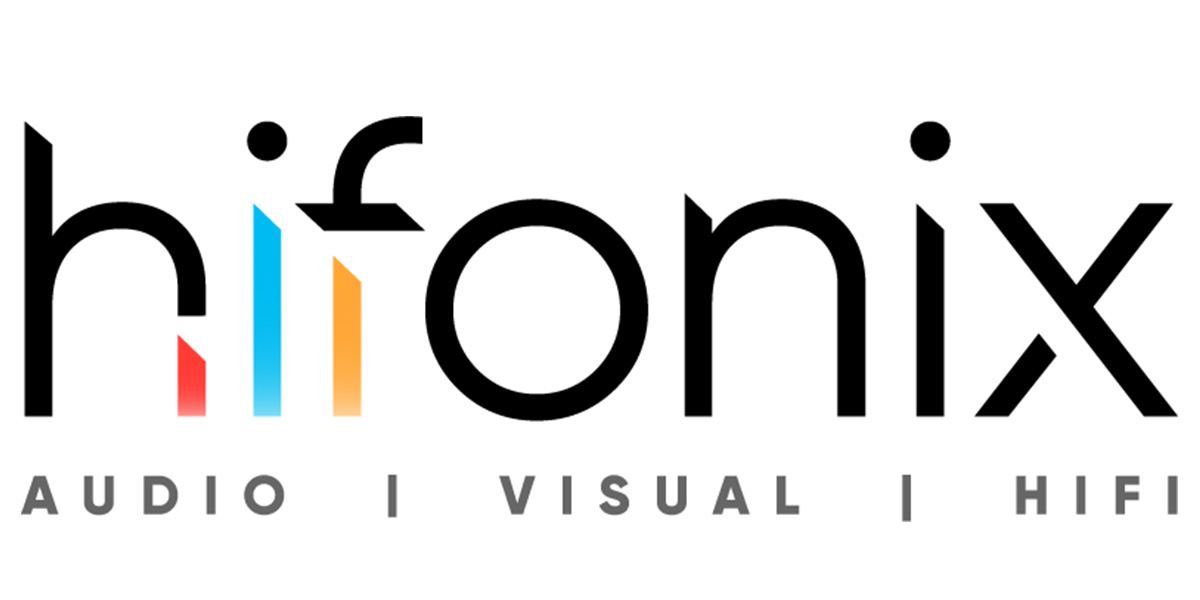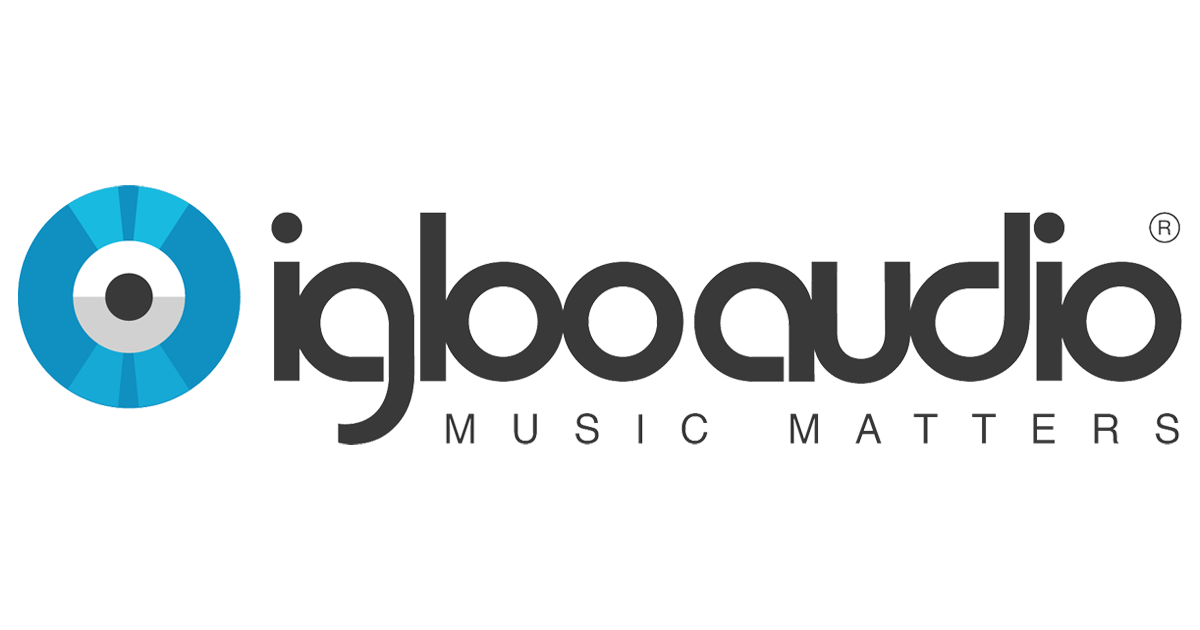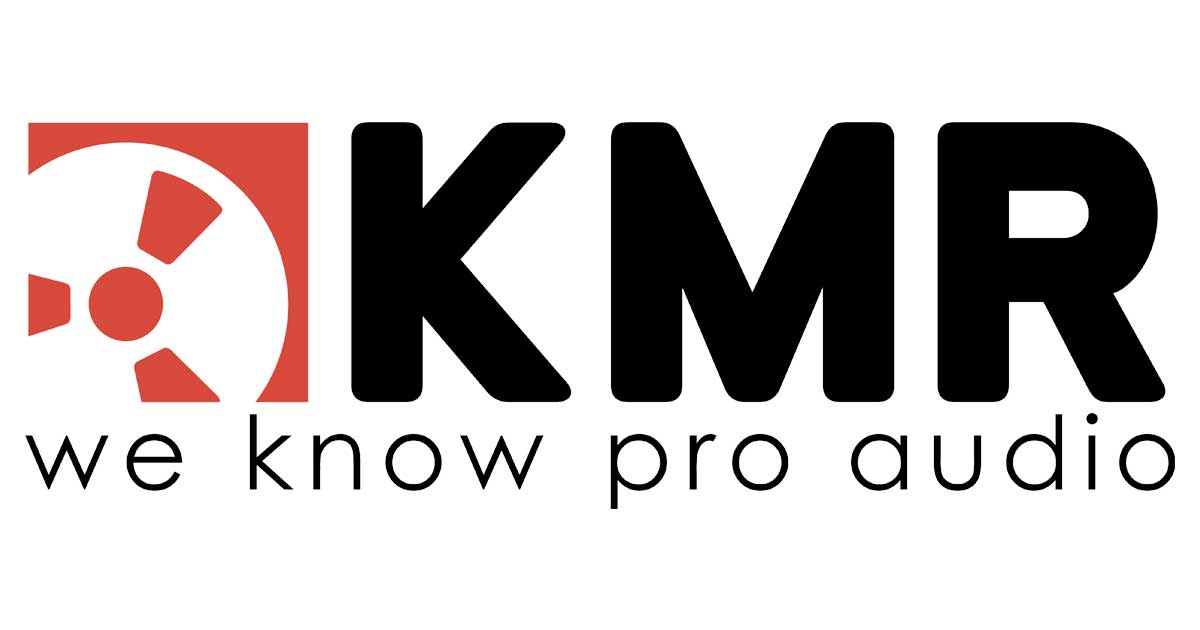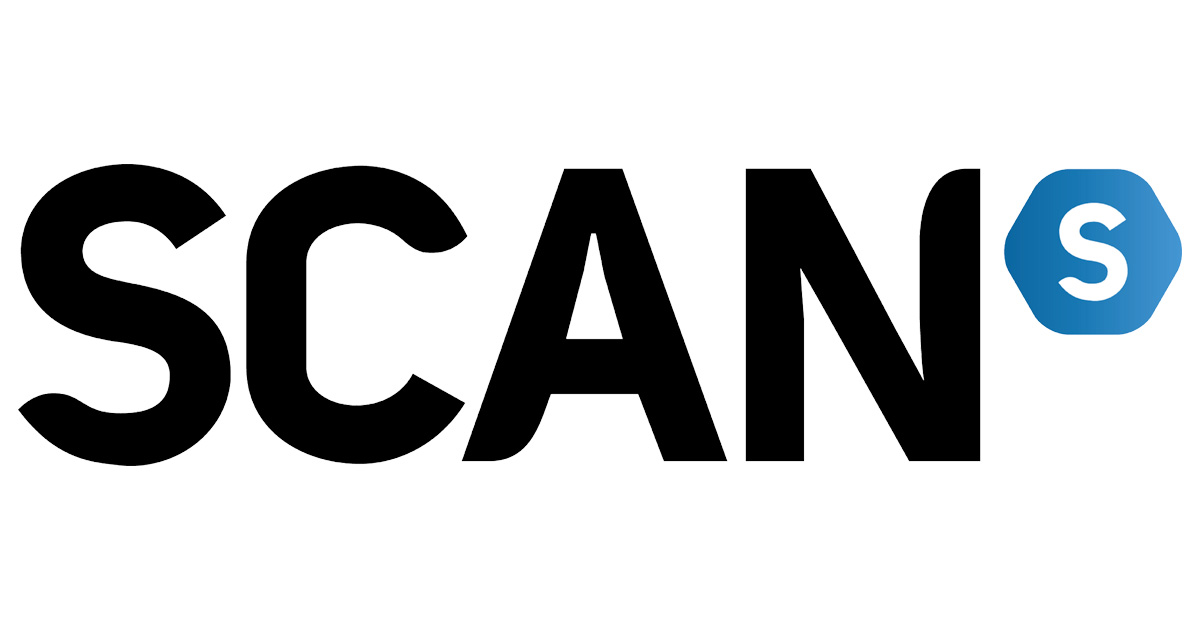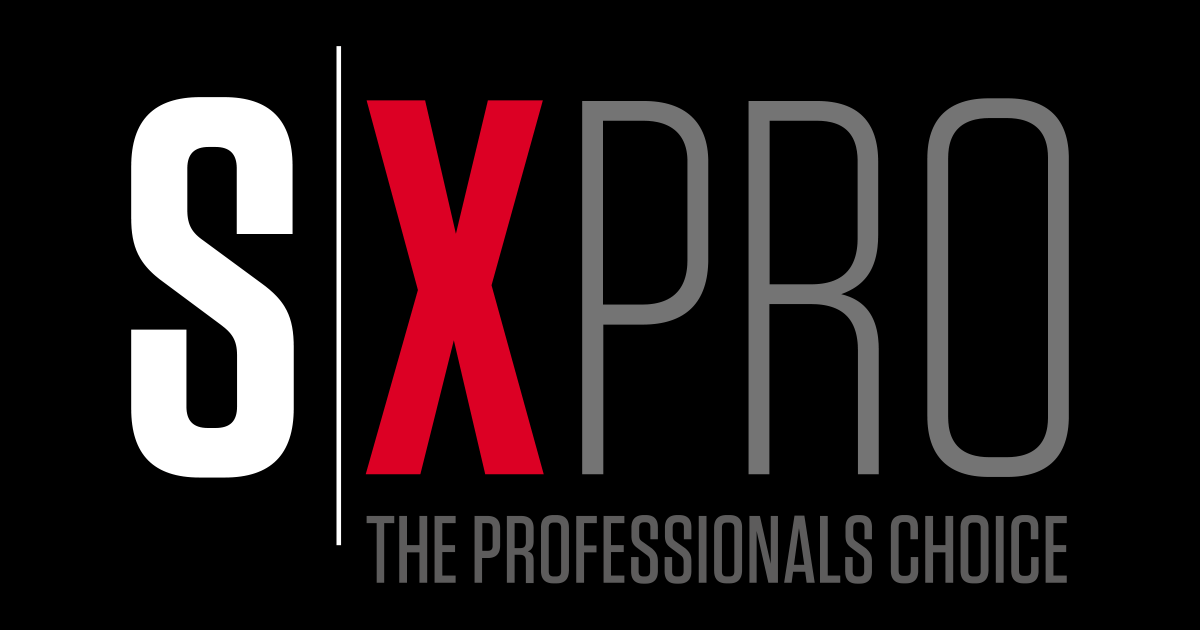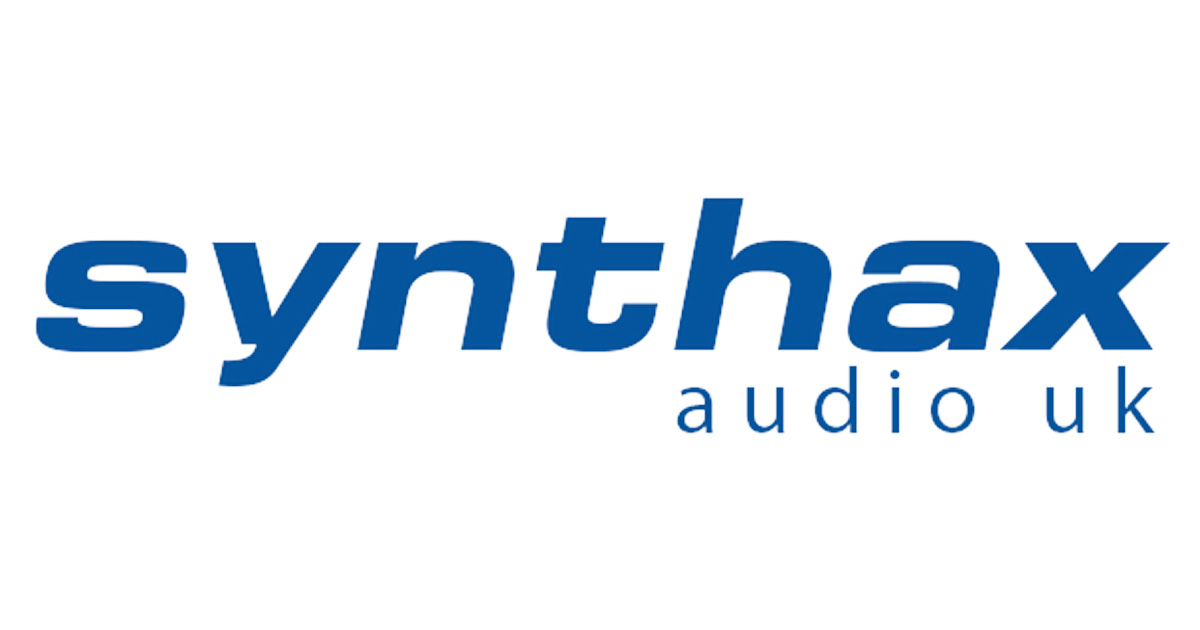Ultra-Fidelity Reference Class Converters
The RME ADI-2 Series is an award-winning range of ADCs, DACs and headphone amplifiers from German pro audio specialists RME Audio.
Adapted from its beginnings as a studio and mastering converter of the highest quality, the latest generation of ADI-2s have been optimised for the Audiophile and home Hi-Fi markets, with a host of fresh ideas, innovative features and numerous useful functions.
Combining high-end DA conversion with exceptional headphone outputs, remote control and USB operation, the ADI-2 DAC and Pro FS R have received countless enthusiastic reviews for their sound, flexibility, and technical capabilities.
Welcome to a new standard of digital audio technology: This is RME.
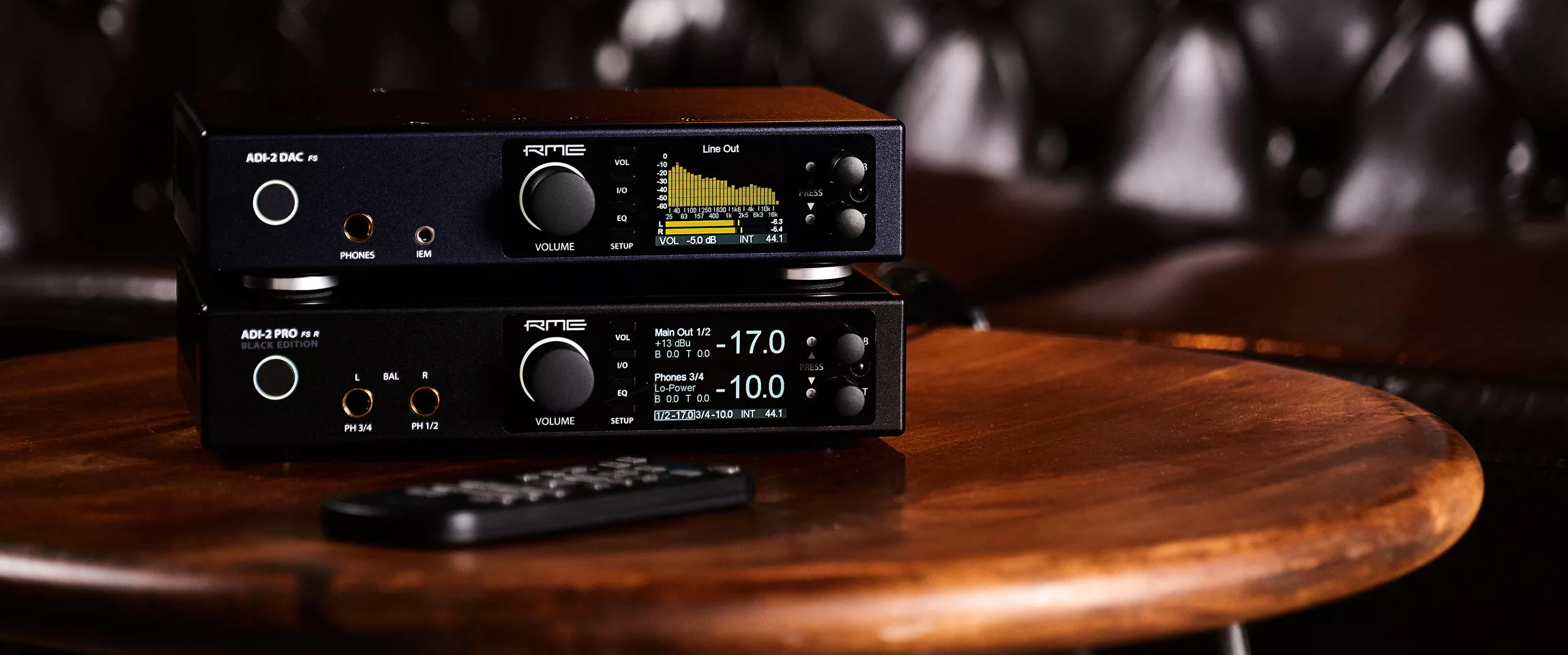
RME ADI-2 DAC FSReference-Class USB-DAC
|
RME ADI-2 PRO FS R2-In / 2-Out Mastering-Grade
|
RME ADI-2/4 PRO SE2-In / 4-Out Mastering-Grade
|
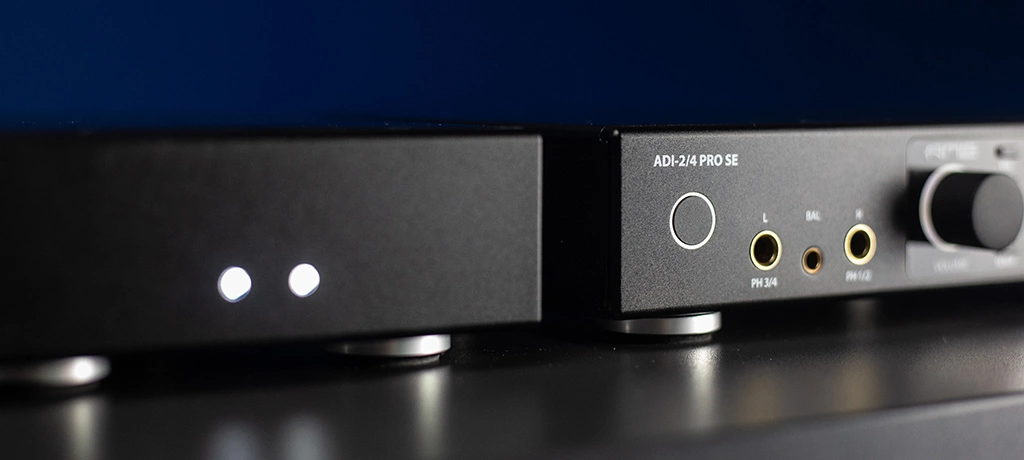
RME ADI-2 Series Remote Software Tutorial (Mac/Windows)
Watch more ADI-2 Series videos at
YouTube.com/RMEAudio
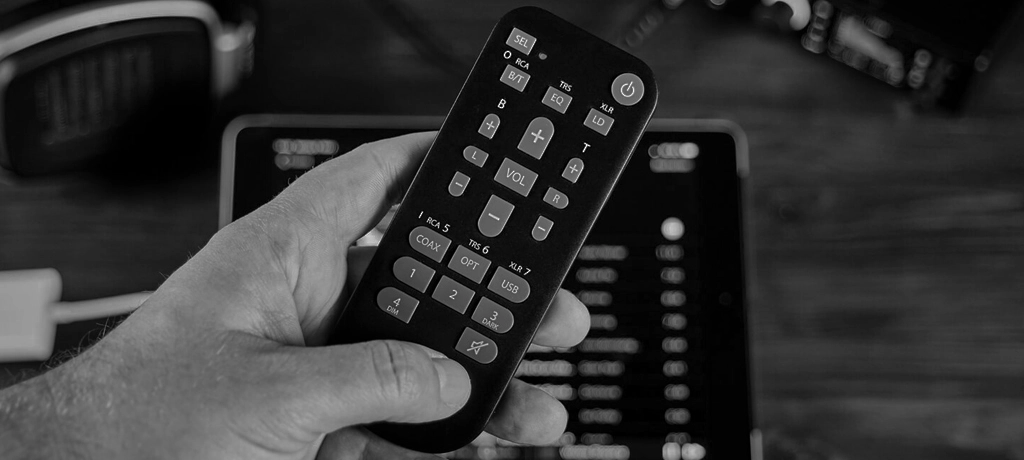
RME ADI-2 Series Reviews

A genuinely high-end performance standard
"I am very impressed with all that it can do, and the ease and quality with which it does it…"
- Sound On Sound
Read More: Sound On Sound Review

The sound quality is superb
"This is not just a DAC that’s ‘worth a try’... You have to audition this!"
- Resolution Magazine
Read More: Resolution Magazine Review

*The* DAC to beat at €1K!
"In terms of value for money, I’ve never come across a DAC beneath a grand that offers so much..."
John Darko (Darko.Audio)
Read More: Darko.Audio Review

A Qutest Killer?
“This is a DAC punching as a heavyweight but at relative welterweight prices…
…value for money is incredibly stellar here.”
- 13th Note HiFi
Read More: 13th Note HiFi Review
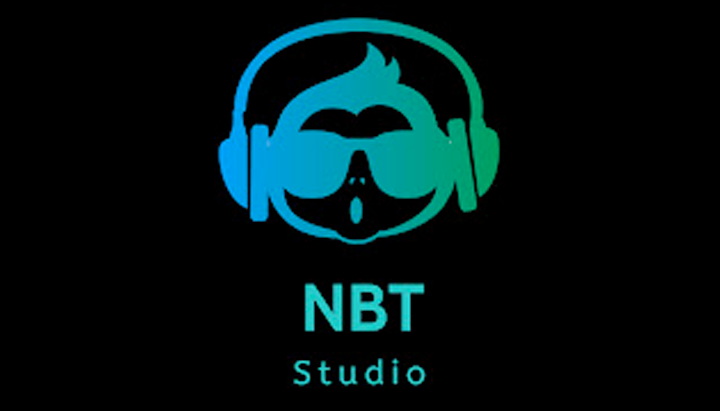
Replaced 3 hifi components in my system
"[The RME ADI-2 DAC] is an absolute gem, this is my favourite unit to date!"
- The Next Best Thing Studio
Watch the video: The Next Best Thing Studio Review
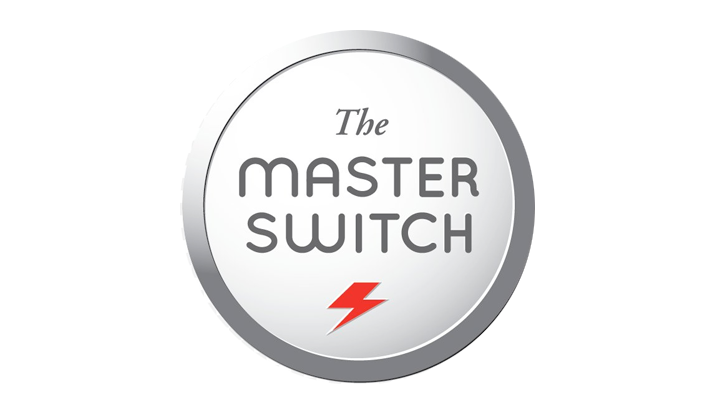
Ridiculous sound quality, unbelievable value.
"One of the best-sounding pieces of audio equipment we’ve ever heard. Not just one of the best DACs; one of the best anything, period."
- The Master Switch
Read More: The Master Switch Review

Extremely impressive
“You can really ‘hear into a mix’, easily differentiating electronic reverb tails from natural acoustic reverberant spaces.”
- HiFi+ Magazine
Read More: HiFi+ Magazine Review
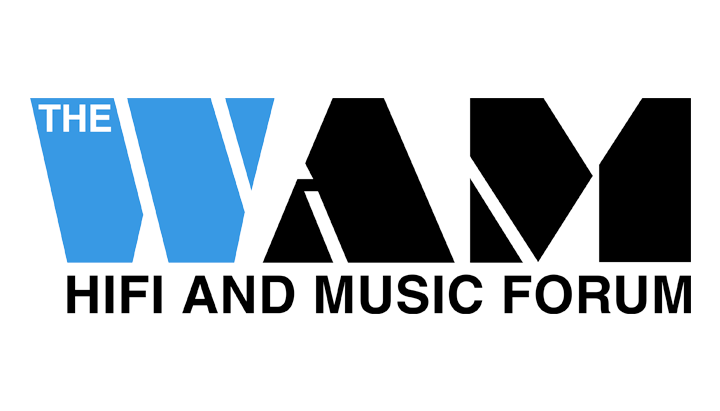
Very good value for money
“Better than my £1K references (already the best sub-£1K DACs I had heard), and it could be preferred to another twice as expensive...”
- HiFi Wigwam
Read More: HiFi Wigwam Review

Technically marvellous
“I can’t think of any other desktop DAC/amp combo that would be easier to recommend…"
- Headfonics
Read More: Headfonics Review

Unrivalled functionality
"Highly resolving in detail, neutral in tonality, and it manages to do that whilst sounding natural at the same time"
- HiFi Wigwam
Watch the video: A British Audiophile Review
RME ADI-2 Pro FS R Reviews

Cons? None!
"I can’t think of another two-channel A-D/D-A converter that can match the ADI-2 Pro’s versatility, and few can match its technical performance."
- Sound On Sound
Read More: Sound On Sound Review

An absolute snip
"The ADI-2 Pro FS really does pack a punch with a host of really useful features and benefits.
So far I have only scratched the surface of what it can really do."
- Pro Tools Expert
Read More: Pro Tools Expert Review

The 'tinkerer’s' paradise
"If I were to describe it in one word, it’s so clean. Absolutely clean.
No matter what volume level, it was just, ‘consistent’."
- Jay’s Iyagi
Watch the video: Jay’s Iyagi Review

Very clean and distortion-free
"The specs on these headphone outs are also insane…
Even for audiophiles, these headphones amps are really great."
- TechReflex
Watch the video: TechReflex Review

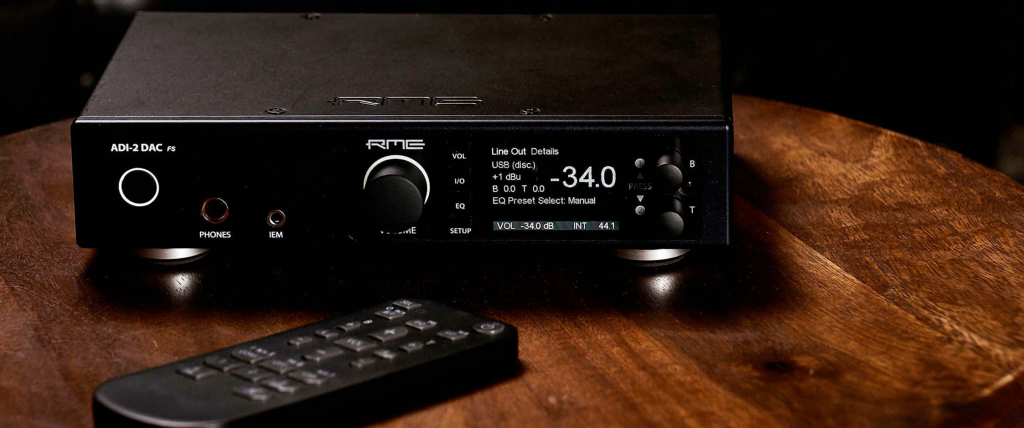
Features & Technologies
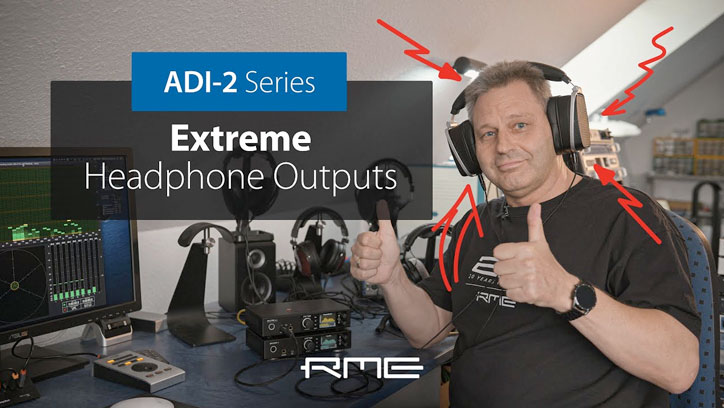
Extreme Power Headphone Outputs
There is no use in boasting about -110 dB THD, when such values are not available in real world operation - for example when a 32 ohm headphone is connected. RME's engineers therefore designed a new headphone output stage that brings the full performance of the premium DAC to the phone jack - even when using low impedance headphones.
The Extreme Power design excels with 0.1 Ohm output impedance, a maximum output level of +22 dBu, and a maximum output power of 1.5 Watts - per channel! The two, fully separated stereo headphone outputs deliver the same 120 dBA SNR performance as the line outputs, for a full hum and noise free listening experience. THD is far below -100 dB (0.001%) even at full power, for the most clear and detailed soundstage possible. The Extreme Power design also incorporates current limiting, power surveillance, overload detection and DC protection. A low power mode and a high power mode are provided, for a perfect match from IEM up to planar.
Super Low Noise for IEM lovers
The headphone revolution not only brought headphones but also IEMs (in ear monitors) back into the attention of audiophiles and music lovers. Modern IEMs have a reference sound that easily competes with bulky over-ear headphones, making them not only a mobile alternative, but also an interesting solution in home.
Modern IEMs are extremely sensitive and operate on very low voltages. As a side effect they uncover the noise floor of the player, DAC or headphone amp. When RME developed its Extreme Power headphone stage the basic noise floor was taken care to be as low as possible, which was then confirmed in many reviews - even when used with IEMs.
Still RME wanted to make sure that even the most sensitive IEM combined with the most sensitive listener receive the full dynamic range on playback.
RME's solution? Adding the most advanced IEM output imaginable as second phones connection to the front of the ADI-2 DAC. Its ground noise floor is an astounding 10 dB lower than the one of the Extreme Power output (black hole background…), output impedance is near zero Ohms, THD reaches new record lows, click-free on/off is included as well as volume ramp-up, and the sound quality with any IEM is just amazing. We're sure you will love it!
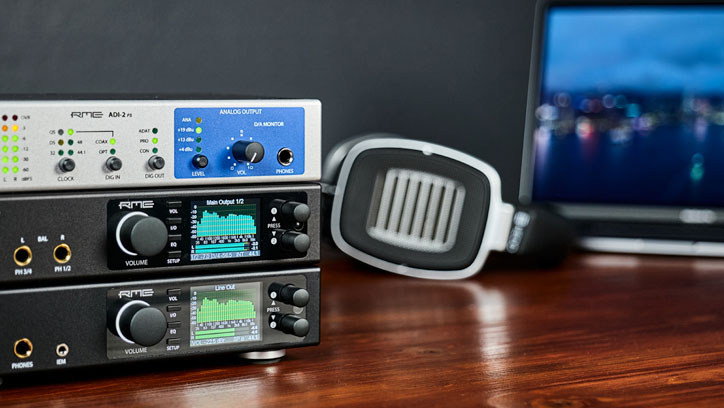
High-Resolution Desktop Recording & Playback Solution
The RME ADI-2 DAC FS and ADI-2 Pro FS R can both operate in Class Compliant mode (UAC 2.0), allowing for recording and playback with computers, phones and tablets running operating systems like iOS, Mac OSX, Linux and Windows 10 (since 1709).
Upon connection via USB, the device will be automatically recognized - no proprietary driver installation is required - providing Macs, PCs and iOS devices with professional I/O connections, such as balanced and unbalanced line outputs, Extreme Power and IEM headphone outputs (that excel with both low and high impedance headphones), extensive gain and level adjustments, SPDIF inputs, PCM playback at up to 768kHz, and DSD playback at up to 11.2 MHz (DSD256).
Note: the ADI-2 DAC FS and ADI-2 Pro FS R do not supply power to the iPad/iPhone. The latest Lightning to USB 3 Camera Adapter from Apple includes a Lightning socket to connect the standard Apple power supply, allowing to charge the i-device while it operates in Class Compliant mode with the ADI-2 Series.
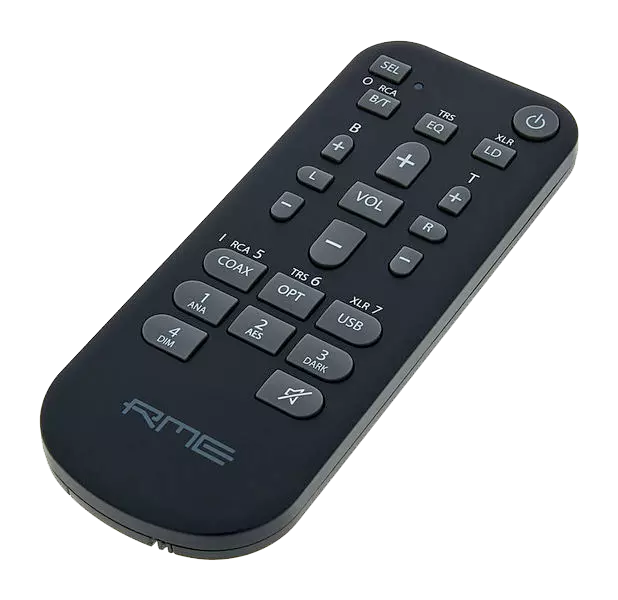
User-Definable Remote Control (excludes ADI-2 FS)
Both the ADI-2 DAC FS and ADI-2 Pro FS R include RME’s Multi-Remote Control, a dedicated wireless remote.
The MRC provides buttons for all of the ADI-2 Series' most commonly used features including Power (On/Off), Volume (+/-), Balance (L-R), Bass and Treble adjustments (+/-), Input Selection (Optical / Coaxial / USB), Mute (On/Off), Loudness (On/Off), Dark Mode (On/Off) and EQ (On/Off).
In addition, four user-definable buttons provide access to a variety of additional functionality, for tailoring the device to suit your own personal experience, or specific usage scenarios. Programmable functions include Crossfeed adjustments, switching between filter types, plus Dim and Mono (On/Off).
Third Party Remote Support
The ADI-2 DAC FS and ADI-2 Pro FS R also support a number of third party remote controls, such as the popular Harmony devices from Logitech.
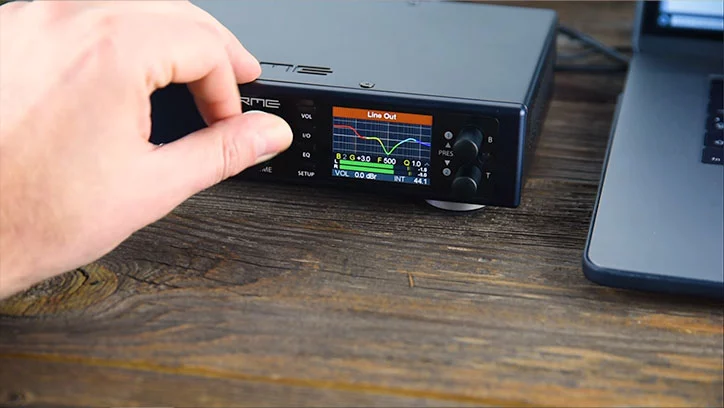
Built-in sound-shaping capabilities
The ADI-2 DAC FS and ADI-2 Pro FS R both feature a selection of additional processing and sonic shaping options, courtesy of the on-board DSP.
For those inquiring minds, the DSP is responsible for the following functionality;
- Bass/Treble and Loudness
- 5-band parametric EQ
- Standard phase functions
- Crossfeed
- 30-Band bi-quad bandpass filter spectral analyzer
- Peak Level meters for all channels
- Display rendering
- Volume control
- Several controller-like functions including volume ramp-up, mute, signal routing control etc.
- DSD to PCM conversion (for level meters)
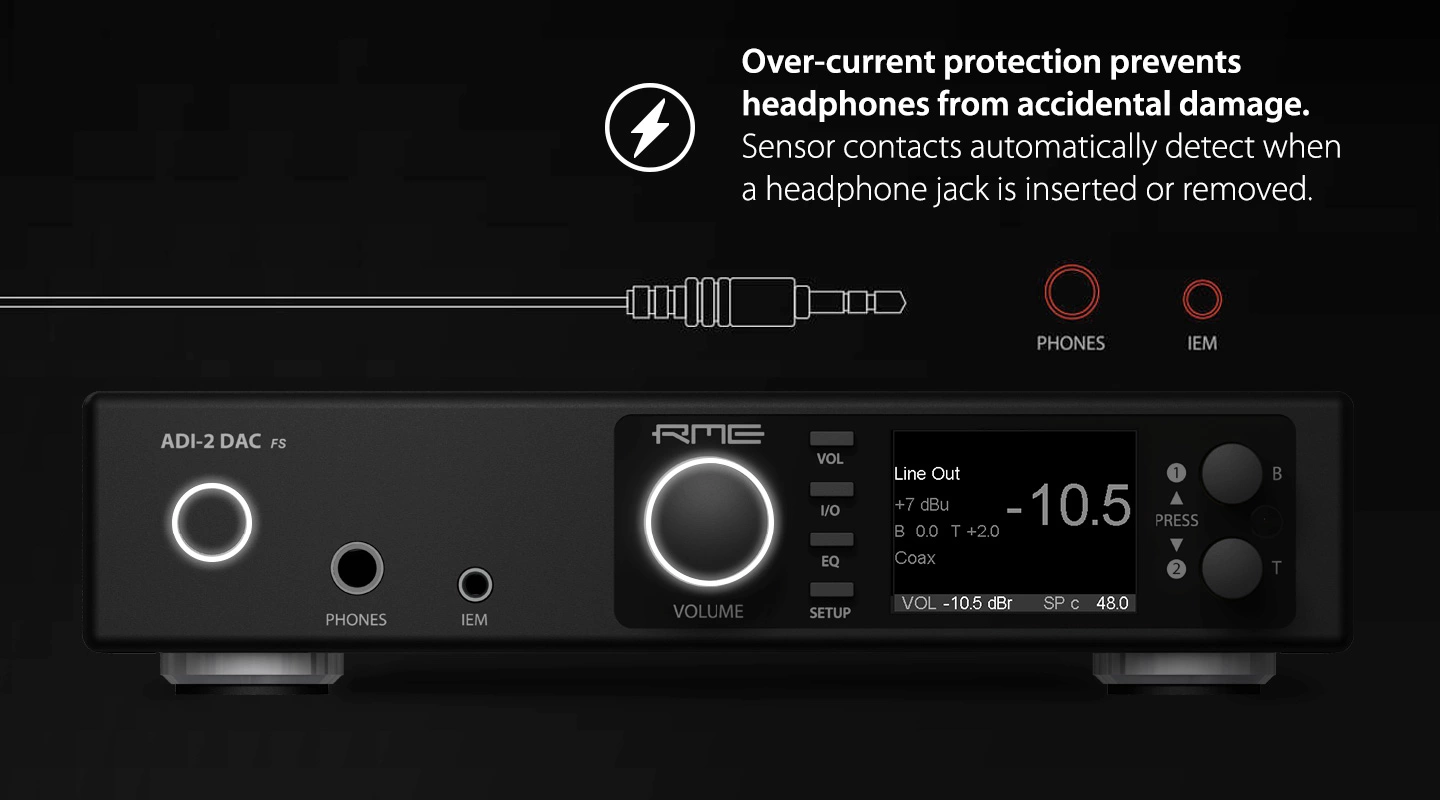
Automatic Headphone Detection
The headphone sockets of the RME ADI-2 DAC FS and Pro FS R feature sensor contacts, for detecting when a headphone jack is inserted or removed.
Once a headphone jack is inserted, the on-board DSP slowly ramps up the volume (from an initially low starting level) to the last volume level used.
This gives the listener a chance to react if the volume has previously been set too loud, and helps to protect against potential damage to headphones (and ears!), by giving the listener time to quickly reduce the volume knob, or simply unplug the phones themselves, with no chance of any equipment damage.
AutoDark Mode
'AutoDark' is the name given to another notable feature found on both the ADI-2 DAC FS and Pro FS R. Added at the request of users on the RME Forum, and made available to all existing users via a free firmware update, AutoDark automatically turns off all lights (and the display) after 10 seconds of user inactivity.
Invaluable for when you want to fully immerse yourself in the music, RME's AutoDark feature is there to help you create a perfect and luxurious listening experience with zero distractions.
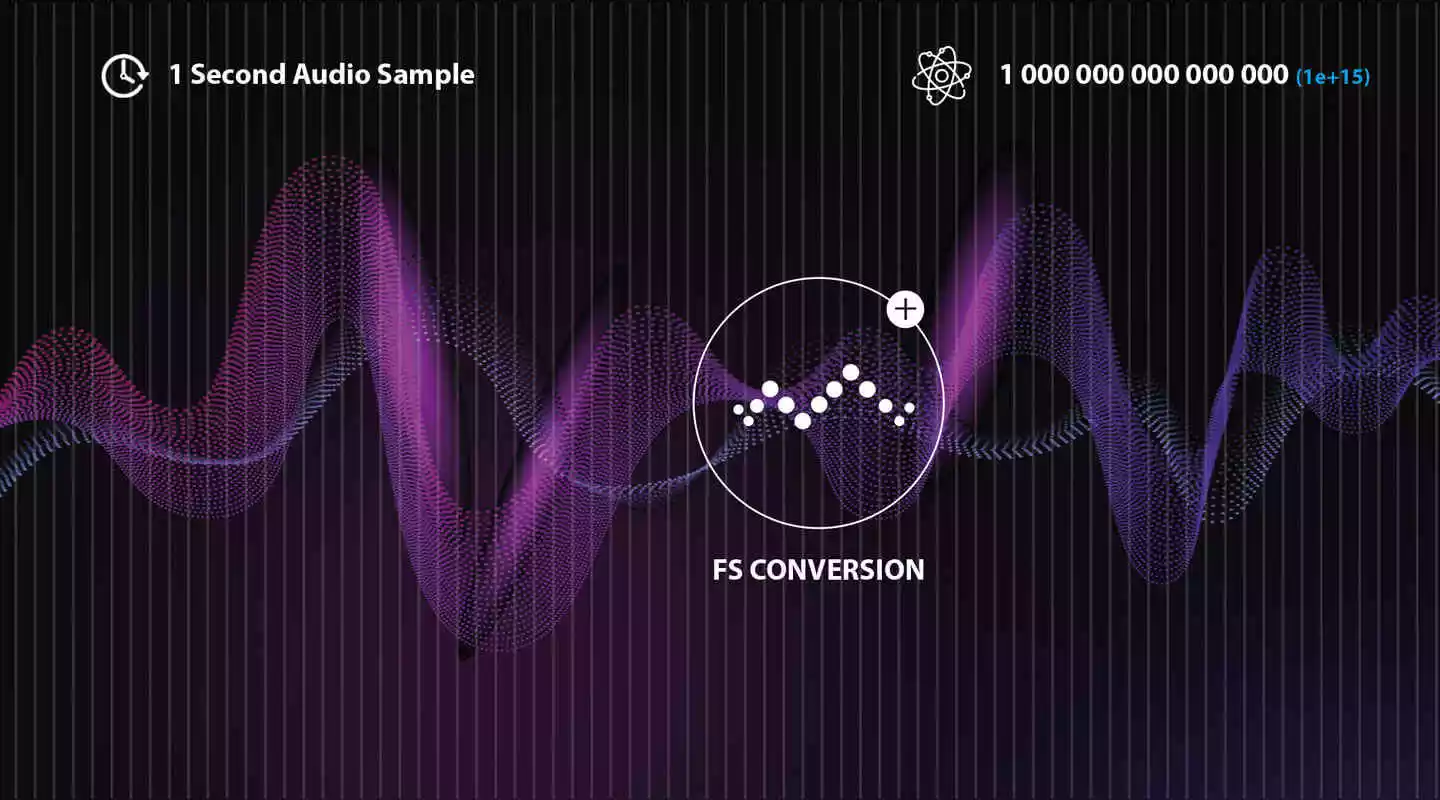
About Jitter
The clock frequency is an essential factor in the world of digital audio, being responsible for the correlation between a digital signal's audio bits and the time reference.
In a perfect world, audio signals would be passed entirely accurately. In practice however, a device's clock frequency develops small fluctuations over time. These fluctuations are commonly referred to as "jitter" - and measured in nanoseconds (ns) - and are the natural-born enemy of any digital audio transfer.
The effects of jitter on the audio signal are many - from a somewhat "rough" sound quality, to diminished treble localisation, and in extreme cases, "clicks" and dropouts. To solve these issues, RME developed a completely new technology for synchronization and jitter suppression in digital audio signals - SteadyClock.
SteadyClock FS - Excellence redefined
There was little to improve with RME's original SteadyClock, which has earned its accolades over the years for its flawless implementation across numerous RME devices.
The highly efficient jitter suppression refreshes and cleans up any incoming clock signal, and provides a high-quality outgoing reference clock for other professional audio devices within a digital system.
At the same time, analogue conversion is performed at an equally high level, completely independent of the quality and type of reference clock used.
With SteadyClock FS, the focus was put on reducing the self jitter of SteadyClock to new lows, by improving its second analogue PLL circuit, and referencing both Direct Digital Synthesis and PLL to a low phase noise quartz crystal. The low phase noise oscillator (which drives the updated circuit) of SteadyClock FS reaches jitter specs lower than a picosecond (ps), to a measurement called femtosecond (fs) - hence "SteadyClock FS".
The result? Self jitter measurements (via the ADI-2 Series' DA conversion) that can usually only be achieved in master quartz clock mode. In addition, SteadyClock continues to run in PLL mode - regardless of whether the internal or an external clock is used, the sound quality remains precisely the same at all times.

DSD Recording & Playback Solutions
DSD stands for Direct Stream Digital, a high-resolution format that reproduces audio signals in an alternative method to that of PCM.
For example, standard CD quality audio produces a 16-Bit, 44.1 kHz file. This 16-Bit information is then sampled 44,100 times per second (or at 44.1 kHz), with the resulting signal converted to analogue via a DAC.
With DSD audio, an alternative method is used to create high-resolution audio, using only a single Bit. At the same time, and as opposed to a CD sample rate’s 44,100 times per second, the signal is instead sampled at over 11.2 million times a second (for Quad-Rate DSD, aka DSD256). The result is a high-resolution audio file which is generated in a completely different way, and remains a favourite among some audiophiles as a listening method.
Both the RME ADI-2 DAC FS and ADI-2 Pro FS R support DSD in various ways (and with sample rates up to 768 kHz), for high-resolution recordings or PCM, DXD and DSD record/playback.
For more information, see page 33 of the ADI-2 DAC FS manual here, or page 44 of the ADI-2 Pro FS R manual here.
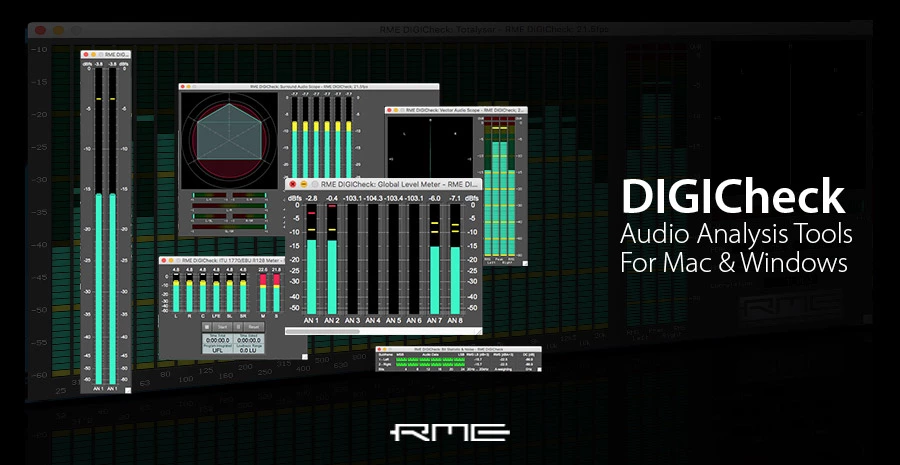
A Free Suite Of Audio Analysis & Measurement Software
RME's DIGICheck software is a sometimes overlooked feature, and a bit of a hidden gem.
Free to all RME users (you can download it from RME's website here), DIGICheck is a suite of highly accurate audio analysis and measurement tools for both Mac and Windows, and will be of benefit to anyone working in recording, mixing, mastering or broadcast.
The set of tools includes comprehensive multi-channel level metering (peak and RMS), plus a spectrum/frequency analyser made up of 30 bands that features freely adjustable rise and release times, customisable display modes, different filter types, and precise level information all the way down to -140 dBFS.
There’s also a correlation meter and vectorscope for checking the phase relationship of stereo signals (and for checking mono compatibility); a loudness metering tool for checking against the IT 1770 / EBU R128 standards commonly found in broadcast; and a Surround Audio Scope for surround sound level metering with extended correlation analysis, ITU weighting and ITU summing.
For more information about RME's DIGICheck, see the RME ADI-2 Pro FS R manual entry here.
Download DIGICheck for Mac and Windows here.

Get a 5 year warranty on all RME Audio devices
Since its inception in 1996, RME Audio has been supplying high-quality audio products to professional recording environments, including studios, live audio, broadcast and research facilities.
The company’s technically accomplished, no-fuss approach has found favour with professional engineers the world over, with RME devices in use day in, day out for years at a time without issue. In fact, one of the terms that we hear repeatedly to describe RME devices is “rock-solid reliability”.
For that reason, here at Synthax Audio UK we’re happy to offer a 5 year warranty on all RME devices, such is our confidence in their quality.
How do I claim my 5 Year Warranty?
It is important to note that the 5 Year Warranty is only available on RME Audio products purchased from an authorised UK dealer (see below). Once you have purchased your unit, simply go to our Warranty Support Area and complete the form. You will then receive confirmation that you have been registered.
RME ADI-2 DAC FS Overview
See more videos at Synthax TV

Where To Buy
The RME ADI-2 Series is available from a number of UK-based retailers (listed below), all of whom keep regular stock of the ADI-2 DAC FS and ADI-Pro FS R.
If you have any questions or want to make sure you’re buying from a reputable source, feel free to contact us ahead of your purchase.
How do I claim my 5 Year Warranty?
It is important to note that the 5 Year Warranty is only available on RME Audio products purchased from an authorised UK dealer.
Once you have purchased your unit, simply go to our Warranty Support Area and complete the form. You will then receive an email confirmation that your device has been registered.
Find your nearest RME UK Dealer:
Authorised UK dealers
Our full list of UK dealers (for all brands) can be found here.
See the full range of RME Audio AD/DA Converters at
Synthax Audio UK
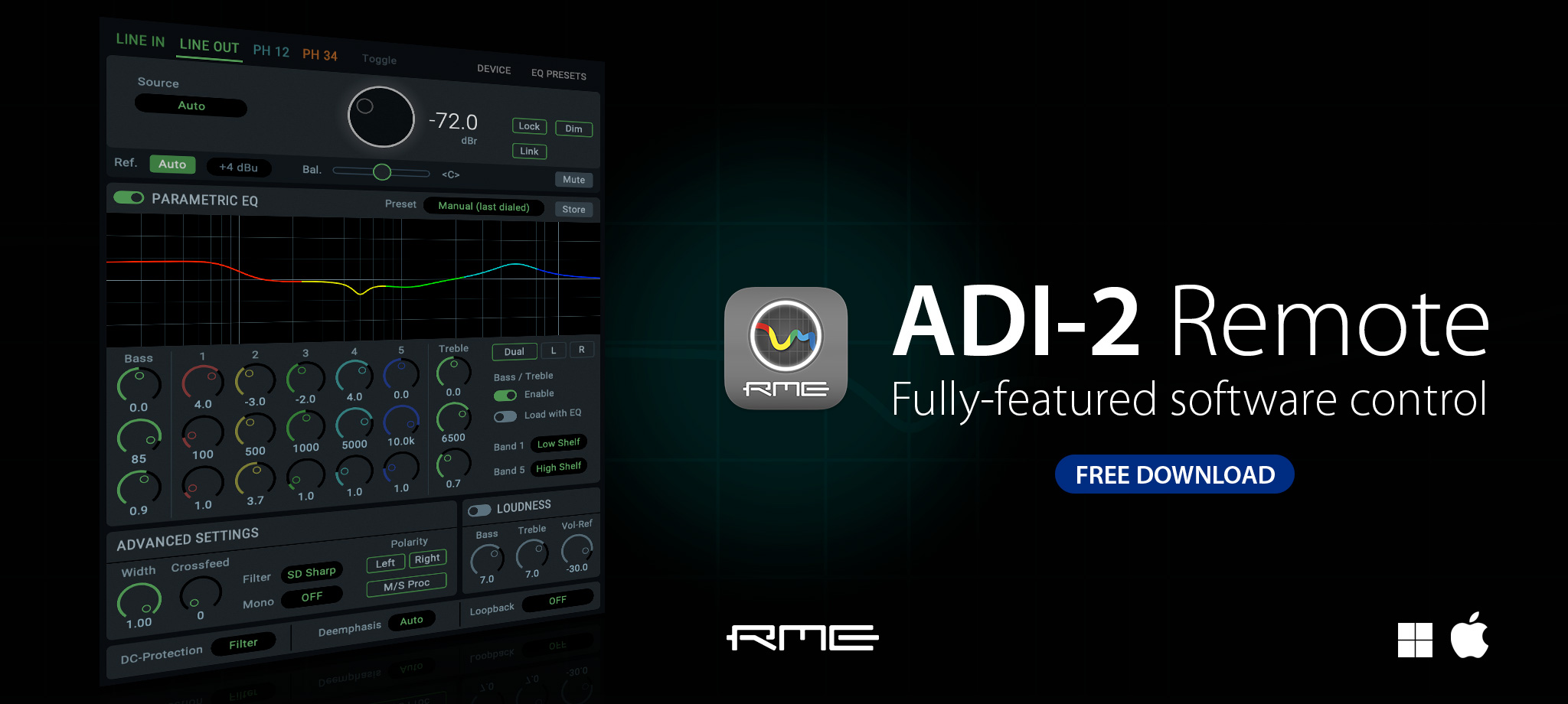
Available from the RME website:
www.rme-audio.de/downloads
If you’d like to know more about any of RME's ADI-2 Series of audiophile ADCs and DACs, give us a call on 01727 821 870 to speak to one of our team or to arrange a demo.
You can also contact us here.



















